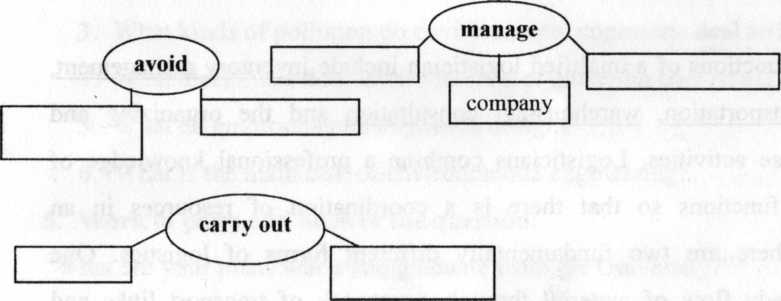
11


Read the text again and answer the following questions:
accident road-work process
people trading purchasing project transportation
What does a supply chain mean?What professional knowledge does a logistics combine?
Why is a logistical support important for international trading?
What is the main goal of logistics?
What are the commercial vehicle operations?
What are some advantages of the intelligent transportation systems?
How does a trucking company control the routes and destinations of the trucks?
Match the nouns and verbs to complete the spidergrams: modern building materials
Answer these questions.
1 .What building materials do you know?
What materials are building materials?
3 .What are they used for?
Today's building technologies are rich of different higher quality materials. Building material is any material,which is used for a construction purpose. Just about every type of available material has been used at one time or another for creating various human and animal homes, structures, and technologies. This reference deals with habitats and structures including homes. Living spaces and their related structures have been created using myriad materials, from mud to metal, and from plastic to grass. Today the production and assembly of various building materials is a multibillion dollar industry, and environmental concern has recently surfaced about the effects of such a massive resource extraction on a global scale.
Mud, rocks, and small plants are used as the most basic naturel building materials, aside from tents made of flexible materials such as cloth or leather. People all over the world have used these three materials together to create homes to suit their local weather conditions. In general stone and brush are used as basic structural components in these buildings, while mud is used to fill in the space between acting as a type of concrete and insulation.Some examples are the wattle and daub mostly used as permanent housing in tropical countries or as summer structures by ancient northern peoples.
Mud and clay Homes built with earth tend to be naturally cool in the summer heat and warm in cold weather. Clay holds heat or cold, releasing it over a period of time like stone. Earthen walls change temperature slowly, so artificially
12
raising or lowering the temperature can use more resources then in say a wood built house, but the heat/coolness stays longer.
Peoples building with mostly dirt and clay, such as cob, sod, and adobe, resulted in homes that have been built for centuries in western and northern Europe as well as the rest of the world, and continue to be built, though on a smaller scale. Some of these buildings have remained habitable for hundreds of years.
Rock structures have existed for as long as history can recall. It is the longest lasting building material available, and is usually readily available. There are many types of rock through out the world all with differing attributes that make them better or worse for particular uses. Rock is a very dense material so it gives a lot of protection too, its main draw-back as a material is its weight .Its energy density is also considered a big draw-back, as stone is hard to keep warm with out using large amounts of heating resources.
Dry-stone walls have been built for as long as humans have put one stone on top of another. Eventually different forms of mortar were used to hold the stones together, cement being the most commonplace now.
The granite-strewn uplands of Dartmoor National Park, United Kingdom, for example, provided ample resources for early settlers. Circular huts were constructed from loose granite rocks throughout the Neolithic and early Bronze Age, and the remains of an estimated 5,000 can still be seen today. Granite continued to be used throughout the Medieval period and into modern times. Mostly stone buildings can be seen in most major cities, some civilisations built entirely with stone such as the Pyramids in Egypt, the Aztec pyramids and the remains of the Inca civilisation.
Thatch is one of the oldest of building materials known; grass is a good insulator and easily harvested. Many African tribes have lived in homes made completely of grasses year round. In Europe, thatch roofs on homes were once prevalent but the material fell out of favour as industrialisation and improved 13
transport improved the availability of other materials. Today, though, the practice is undergoing a revival. In Holland, for instance, two-thirds of new builds have thatched roofs.
Brush structures are built entirely from plant parts and are generally found in tropical areas, such as rainforests, where very large leaves can be used in the building. Native Americans often built brush structures for resting and living in, too. These are built mostly with branches, twigs and leaves, and bark, similar to a beaver's lodge.
Ice was used by the Inuit for igloos, but has also been used for ice hotels as a tourist attraction in northern areas that might not otherwise see many winter tourists.
Wood is a product of trees, and sometimes other fiberous plants, used for construction purposes when cut or pressed into lumber and timber, such as boards, planks and similar materials. It is a generic building material and is used in building just about any type of structure in most climates. Wood can be very t flexible under loads, keeping strength while bending, and is incredibly strong when compressed vertically. There are many differing qualities to the different types of wood, even among same tree species.
Metal is used as structural framework for larger buildings such as skyscrapers, or as an external surface covering. There are many types of metals used for building.
Other metals used include titanium, chrome, gold, silver. These are used as decoration because they are too soft to provide any structural support. Metal figures can be seen used in most cosmopolitan cities. It requires a great deal of human labor to produce metal, especially in the large amounts needed for the building industries.
Glass Clear windows have been used since the invention of glass to cover small openings in a building. They provided humans with the ability to both let

light into rooms while at the same time keeping inclement weather outside. Glass is generally made from mixtures of sand and silicates, and is very brittle.
Modern glass "curtain walls" can be used to cover the entire facade of a building. Glass can also be used to span over a wide roof structure in a "space frame".
Ceramics are such things as tiles, fixtures, etc. Ceramics are mostly used as fixtures or coverings in buildings. Ceramic floors, walls, counter-tops, even ceilings. Many countries use ceramic roofing tiles to cover many buildings.
Building material is any material, which
In general stone and brush are used as basic structural components in these buildings, while mud
Mostly stone buildings can be seen in most major cities....
Many African tribes have lived
Metal figures can be seen used....
f) Modern glass "curtain walls" can be used
4. Give the definitions to the following words:
Mud; rock; thatch; brush; wood; metal; glass; ceramics.
5. Discuss the following questions in a group:
-Compare building materials in different countries.
-What materials are you interested in as future specialists?
-What materials from the text were new to you?
- Which building materials do you think will be popular in the future?
STANDARDIZATION AND CERTIFICATION OF THE PRODUCT
1. Work in a pairs and discuss the following questions.
What does the standardization and certification of the product deal with from your point of view? Discuss your ideas with the class.
What is your idea about the main function of standardization and certification of the product?
2. Read the text below and check whether your ideas are right.
The role of standardization and certification is very vital today. Today in Russia certification and standardization system becomes important and necessary condition for successful economic activities. The factor which increases an urgency of certification is Russia's integration into world economy and its entering into the World Trade Organization.
Russia's product certification system is little more than twelve years old. It is the country's major mechanism for ensuring the quality and safety of products and services.
Legally, product certification in Russia is based on four Russian Federation laws: "On Protection of Consumer Rights," "On Standardization," "On Certification of Products and Services," and "On Ensuring Measurement Uniformity."
Although transport systems follow the same supply and demand theory as other industries, the complications of network effects and choices between non-similar goods (e.g. car and bus travel) make estimating the demand for transportation facilities difficult. The development of models to estimate the likely choices between the non-similar goods involved in transport decisions "discrete choice" models led to the development of the important branch of econometrics.
In transport, demand can be measured in numbers of journeys made or in total distance traveled across all journeys (e.g. passenger-kilometres for public transport or vehicle-kilometres of travel (VKT) for private transport).
D.
Road construction requires the creation of a continuous right-of-way, overcoming geographic obstacles and having grades low enough to permit vehicle or foot travel, and may be required to meet standards set by law or official guidelines. The process is often begun with the removal of earth and rock by digging or blasting, construction of embankments, bridges and tunnels, and removal of vegetation (this may involve deforestation) and followed by the laying of pavement material. A variety of road building equipment is employed in road building
After design, approval, planning, legal and environmental considerations have been addressed alignment of the road is set out by a surveyor. The Radii and gradient are designed and staked out to best suit the natural ground levels and minimize the amount of cut and fill. Great care is taken to preserve reference Benchmarks.Roadways are designed and built for primary use by vehicular and pedestrian traffic. Storm drainage and environmental considerations are a major concern. Erosion and sediment controls are constructed to prevent detrimental effects. Drainage lines are laid with sealed joints in the road easement with runoff coefficients and characteristics adequate for the land zoning and storm water system. Drainage systems must be capable of carrying the ultimate design flow from the upstream catchments with approval for the outfall from the appropriate authority to a watercourse, creek, river or the sea for drainage discharge. A Borrow pit (source for obtaining fill, gravel, and rock) and a water source should be located near or in reasonable distance to the road construction site. Approval from local authorities may be required to draw water or for working (crushing and screening), of materials for construction needs. The top soil and vegetation is removed from the borrow pit and stockpiled for subsequent rehabilitation of the extraction area. Side slopes in the excavation area are not steeper than one vertical to two horizontal for safety reasons.
